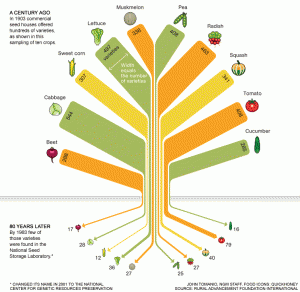
A Food-Variety Tree (see the diagram at the end) prepared by National Geographic Magazine illustrates how the varieties of seeds used for food in the U.S. have shrunk dramatically in the past century. In 1903, for example, commercial seed houses sold 307 varieties of sweet corn, compared to 12 today. This may accelerate with today’s moves toward genetically engineered foods, which also challenge species diversity.
One measure of diversity that resonates with Orthodox theology is the richness of harmony or communication in God’s Creation. Yet as the varieties of species on Earth dwindle at the hands of man, such communication in Creation can become more difficult to engage. Genesis speaks of the seed coming forth in Creation after its kind, and that translated Engish term “kind” shows this: In the Septuagint, the Greek term is related to the modern biological term genus, and has more the meeting of family than the modern term “species.” In reducing eco-diversity, we arguably reduce family life and its rich relationships and communications on Earth.
The richness and absolute value of the symphony or language of Creation is suggested in Dostoevsky’s The Brothers Karamazov by Elder Zosima, whose character is based on the historicalOrthodox Christian elders of Optina Monastery:
“…look around you at the gifts of God, the clear sky, the pure air, the tender grass, the birds; nature is beautiful and sinless, and we, only we, are sinful and foolish, and we don’t understand that life is heaven, for we have only to understand that and it will at once be fulfilled in all its beauty, we shall embrace each other and weep…. for all is like an ocean, all is flowing and blending; a touch in one place sets up movement at the other end of the earth. It may be senseless to beg forgiveness of the birds, but birds would be happier at your side–a little happier, anyway–and children and all animals, if you were nobler than you are now. It’s all like an ocean, I tell you” (Constance Garnett translation).
St. Maximus the Confessor in the 7th century used the image of the All-tree to express the combined transcendence and immanence in Creation of the logoi of the Logos. Maximus wrote that the logoi are like birds on the branches of the Tree of Life that is the Logos, grown from the mustard seed of faith; the logoi of intelligible beings are compared to the blood, and the logoi of sensible things to the flesh, of the Logos-Tree. (See Lars Thunberg, Man and the Cosmos: The Vision of St. Maximus the Confessor (Crestwood, NY: St. Vladimir’s Seminary Press, 1997), pp. 138–39.)
Blog posts do not necessarily represent the views of OFT.
